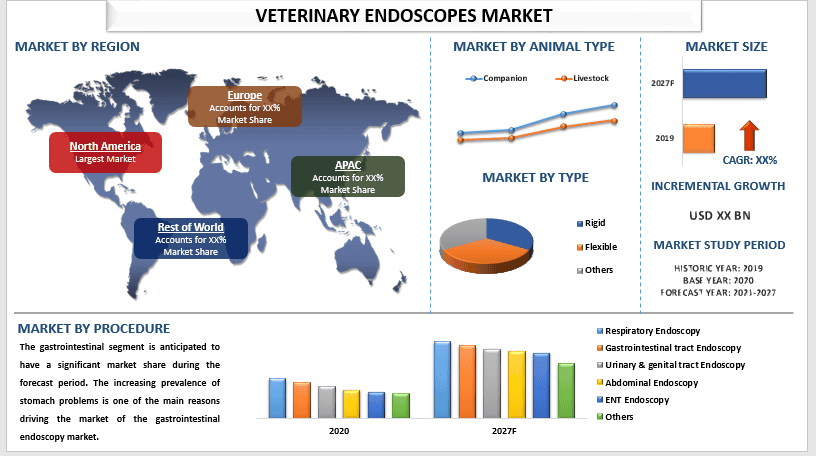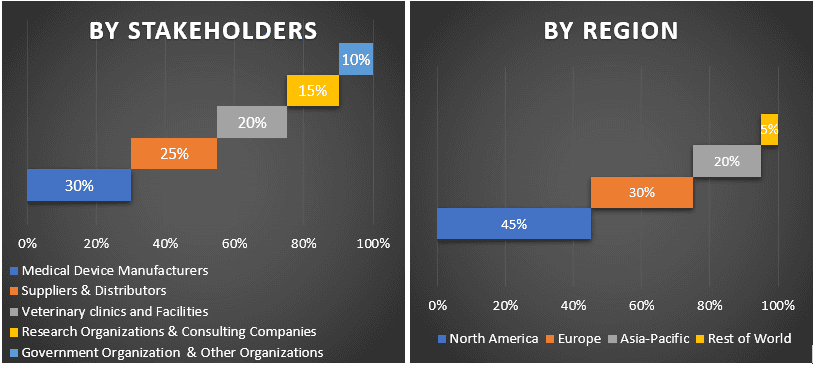- Home
- About Us
- Industry
- Services
- Reading
- Contact Us
Veterinary Endoscopes Market: Current Analysis and Forecast (2021-2027)
Emphasis on Type (Rigid, Flexible, and Others); Animal Type (Livestock and Companion); Procedure (Respiratory Endoscopy, Gastrointestinal Tract Endoscopy, Urinary & Genital Tract Endoscopy, Abdominal Endoscopy, ENT Endoscopy, and Others); Region/Country

The Global Veterinary Endoscopes Market is anticipated to grow with an elevated CAGR of around 7% over the forecast period (2021-2027). Endoscopy is a minimally invasive procedure that allows the examiner to look within an organ or body cavity and gain diagnostic information, which includes grossly evaluating an area of interest and obtaining tissue for histopathologic evaluation.
The increasing efforts on animal conservation is one of the main reasons for the involvement of modern technology to identify the disease in the animal which significantly increases the market size. Furthermore, the acceleration in the breeding programs of the endangered species is likely to have a positive impact on the endoscopes market. Additionally, the increasing number of diseases in the livestock and pet population is an important factor for significant market growth of the veterinary endoscope market.
Steris, MDS Incorporated, Firefly Global, eKuore, KARL STORZ SE & Co. KG, Advanced Monitors Corporation, Dr. Fritz Endoscopes GmbH, Zhuhai Seesheen Medical Technology Co., Ltd., Biovision Veterinary Endoscopy, LLC, and Eickemeyer. Several M&As along with partnerships have been undertaken by these players to facilitate customers with new varieties of Veterinary endoscopes.
Insights Presented in the Report
“Amongst type, flexible endoscopes hold the major share”
Based on the type, the market is segmented into rigid, flexible, and others. The flexible segment held a significant market share and is anticipated to witness significant growth during the forecast period. Increasing adoption of minimally invasive and painless procedures attributes to the segmental growth of flexible endoscopes in the market. Furthermore, these endoscopes provide detailed information about the internal organs such as the heart and liver that enabling the practitioners to diagnose and treat the disease efficiently.
“Amongst animal type, livestock hold the major share”
Based on animal type, the market is segmented into livestock and companion. The livestock market segment is expected to witness lucrative growth during the forecast period. This is mainly due to the increasing breeding programs in the livestock population for the food and fiber industry. Furthermore, the rural economies are largely dependent on the livestock population and the government encourages breeding programs for rural development which results in the increasing demand for better veterinary treatments and diagnostics. For instance, The Rashtriya Gokul Mission (RGM) is being implemented for the development and conservation of indigenous bovine breeds since December 2014. The scheme is crucial for the upliftment of rural poor as more than 80% low producing indigenous animals are with small and marginal farmers and landless laborers.
Amongst procedure, gastrointestinal tract endoscopy hold the major share”
Based on procedure, the market is segmented into respiratory endoscopy, gastrointestinal tract endoscopy, urinary & genital tract endoscopy, abdominal endoscopy, ENT endoscopy, and others. The gastrointestinal tract endoscopy is expected to witness lucrative growth during the forecast period. The increasing incidences of gastrointestinal diseases in animals are one of the major reasons for the growth of the segment in the veterinary endoscopes market. For instance, Lymphangiectasia is a malformation of the intestinal lymphatic system that results in a protein-losing enteropathy that may be congenital or acquired, with a 50% incidence in Norwegian Lundehunds in the USA
“North America represents one of the largest markets of veterinary endoscopes market”
For a better understanding of the market dynamics of the veterinary endoscopes market, a detailed analysis was conducted for different regions across the globe including North America (U.S, Canada, and the Rest of North America), Europe (Germany, France, Spain, United Kingdom, Italy, and Rest of Europe), Asia-Pacific (China, India, Australia, Japan, and Rest of APAC), Rest of World has been conducted. In 2020, North America grabbed a significant market share of the global veterinary endoscopes market 2020. It is expected to grow with considerable CAGR during the forecast period (2021-2027F). The presence of a large livestock population and pets is responsible for the significant growth of the veterinary endoscopes in the region. For instance, as per USDA, till January 2022, the cows and heifers population accounted for 39.5 million. Among these, beef cows accounted for 30.1 million in 2022. Furthermore, the higher per-capita income in the region is also responsible for the regional growth in the veterinary endoscope market.
Reasons to buy this report:
- The study includes market sizing and forecasting analysis validated by authenticated key industry experts
- The report presents a quick review of overall industry performance at one glance
- The report covers an in-depth analysis of prominent industry peers with a primary focus on key business financials, product portfolio, expansion strategies, and recent developments
- Detailed examination of drivers, restraints, key trends, and opportunities prevailing in the industry
- The study comprehensively covers the market across different segments
- Deep dive regional level analysis of the industry
Customization Options:
The global Veterinary endoscopes market can further be customized as per the requirement or any other market segment. Besides this, UMI understands that you may have your own business needs, hence feel free to connect with us to get a report that completely suits your requirements.
Table of Content
Research Methodology for the Global Veterinary Endoscopes Market Analysis (2021-2027)
Analyzing the historical market, estimating the current market, and forecasting the future market of the global veterinary endoscopes market were the three major steps undertaken to create and analyze the adoption of veterinary endoscopes in major regions globally. Exhaustive secondary research was conducted to collect the historical market numbers and estimate the current market size. Secondly, to validate these insights, numerous findings and assumptions were taken into consideration. Moreover, exhaustive primary interviews were also conducted, with industry experts across the value chain of the global veterinary endoscopes market. Post assumption and validation of market numbers through primary interviews, we employed a top-down/bottom-up approach to forecasting the complete market size. Thereafter, market breakdown and data triangulation methods were adopted to estimate and analyze the market size of segments and sub-segments of the industry pertains to. Detailed methodology is explained below:
Seek More Details About Research Methodology
Analysis of Historical Market Size
Step 1: In-Depth Study of Secondary Sources:
Detail secondary study was conducted to obtain the historical market size of the veterinary endoscopes through company internal sources such as annual reports & financial statements, performance presentations, press releases, etc., and external sources including journals, news & articles, government publications, competitor publications, sector reports, third-party database, and other credible publications.
Step 2: Market Segmentation:
After obtaining the historical market size of the veterinary endoscopes market, we conducted a detailed secondary analysis to gather historical market insights and share for different segments & sub-segments for major regions. Major segments included in the report as animal type, type, and procedure. Further country-level analyses were conducted to evaluate the overall adoption of veterinary endoscopes across the globe.
Step 3: Factor Analysis:
After acquiring the historical market size of different segments and sub-segments, we conducted a detailed factor analysis to estimate the current market size of the veterinary endoscopes. Further, we conducted factor analysis using dependent and independent variables such as the growing number of people with chronic diseases and the increasing elderly population all over the globe. A thorough analysis was conducted for demand and supply-side scenarios considering top partnerships, mergers and acquisitions, business expansion, and product launches in the veterinary endoscopes sector across the globe.
Current Market Size Estimate & Forecast
Current Market Sizing: Based on actionable insights from the above 3 steps, we arrived at the current market size, key players in the veterinary endoscopes market, and market shares of the segments. All the required percentage shares split, and market breakdowns were determined using the above-mentioned secondary approach and were verified through primary interviews.
Estimation & Forecasting: For market estimation and forecast, weights were assigned to different factors including drivers & trends, restraints, and opportunities available for the stakeholders. After analyzing these factors, relevant forecasting techniques i.e., top-down/bottom-up approach were applied to arrive at the market forecast about 2027 for different segments and subsegments across the major markets globally. The research methodology adopted to estimate the market size encompasses:
- The industry’s market size, in terms of value (US$) and the adoption rate of veterinary endoscopes across the major markets domestically
- All percentage shares, splits, and breakdowns of market segments and sub-segments
- Key players in the veterinary endoscopes market in terms of products offered. Also, the growth strategies adopted by these players to compete in the fast-growing market
Market Size and Share Validation
Primary Research: In-depth interviews were conducted with the Key Opinion Leaders (KOLs) including Top Level Executives (CXO/VPs, Sales Head, Marketing Head, Operational Head, Regional Head, Country Head, etc.) across major regions. Primary research findings were then summarized, and statistical analysis was performed to prove the stated hypothesis. Inputs from primary research were consolidated with secondary findings, hence turning information into actionable insights.
Split of Primary Participants in Different Regions

Market Engineering
Data triangulation technique was employed to complete the overall market estimation and to arrive at precise statistical numbers of each segment and sub-segment of the veterinary endoscopes market. Data was split into several segments & sub-segments post studying various parameters and trends in the areas of type, animal type, and procedure of the veterinary endoscopes market.
The main objective of the veterinary endoscopes market study
The current & future market trends of veterinary endoscopes were pinpointed in the study. Investors can gain strategic insights to base their discretion for investments on the qualitative and quantitative analysis performed in the study. Current and future market trends determined the overall attractiveness of the market at a regional level, providing a platform for the industrial participant to exploit the untapped market to benefit as a first-mover advantage. Other quantitative goals of the studies include:
- Analyze the current and forecast market size of veterinary endoscopes in terms of value (US$). Also, analyze the current and forecast market size of different segments and sub-segments
- Segments in the study include areas of type, animal type, and procedure
- Define and analysis of the regulatory framework for the veterinary endoscopes industry
- Analyze the value chain involved with the presence of various intermediaries, along with analyzing customer and competitor behaviors of the industry
- Analyze the current and forecast market size of the veterinary endoscopes market for the major region
- Major regions studied in the report include North America, Europe, Asia-Pacific and Rest of the world
- Company profiles of the veterinary endoscopes market and the growth strategies adopted by the market players to sustain in the fast-growing market
- Deep dive regional level analysis of the industry
Related Reports
Customers who bought this item also bought










